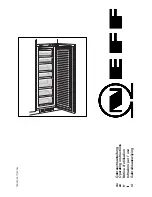
It is possible to switch on the
device manually when
needed (refer to
"DYNAMICAIR function").
The DYNAMICAIR device
stops when the door is open
and restarts immediately
after the door closing.
5.8
Ice-cube production
This appliance is equipped with one or
more trays for the production of ice-
cubes.
Do not use metallic
instruments to remove the
trays from the freezer.
1.
Fill these trays with water
2.
Put the ice trays in the freezer
compartment.
5.9
Cold accumulators
The freezer contains at least one cold
accumulator which increases storage
time in the event of a power cut or
breakdown.
6.
HINTS AND TIPS
6.1
Normal operating sounds
The following sounds are normal during
operation:
• A faint gurgling and bubbling sound
from coils sound when refrigerant is
pumped.
• A whirring and pulsating sound from
the compressor when refrigerant is
pumped.
• A sudden cracking noise from inside
appliance caused by thermic
dilatation (a natural and not
dangerous physical phenomenon).
• A faint click noise from the
temperature regulator when the
compressor switches on or off.
6.2
Hints for energy saving
• Do not open the door frequently or
leave it open longer than absolutely
necessary.
• Do not remove the cold accumulators
from the freezer basket.
6.3
Hints for fresh food
refrigeration
To obtain the best performance:
• do not store warm food or
evaporating liquids in the refrigerator
• do cover or wrap the food, particularly
if it has a strong flavour
• position food so that air can circulate
freely around it
6.4
Hints for refrigeration
Useful hints:
• Meat (all types): wrap in a suitable
packaging and place it on the glass
shelf above the vegetable drawer.
Store meat for at most 1-2 days.
• Cooked foods, cold dishes: cover and
place on any shelf.
• Fruit and vegetables: clean
thoroughly and place in a special
drawer. Bananas, potatoes, onions
and garlic must not be kept in the
refrigerator if not packed.
• Butter and cheese: place in a special
airtight container or wrap in an
aluminium foil or a polythene bag to
exclude as much air as possible.
• Bottles: close with a cap and place on
the door bottle shelf, or (if available)
on the bottle rack.
www.aeg.com
12






































